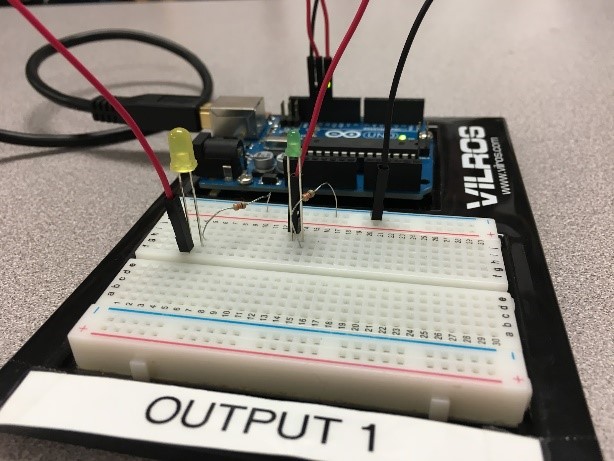Modeling & Designing a Sensory Substitution Device
A 4-5 Week STEAM Curriculum Unit for Middle School Science Classes 
The nervous system is an integral part of the human body. It receives information from the environment through sensory neurons, processes that information, and results in a response through motor neurons. Communication in neural networks occurs through both electrical and chemical signals. Similarly, electrical circuits can involve sensory input (temperature, pressure, light), processing of the input using logic gates, and a resulting output (light, motor). This parallel of the nervous system and electronic circuits is central to the field of neural engineering. Engineers identify a problem based on a need (in this case, the loss of a sense), design solutions (sensory substitution), test and evaluate their solutions, and modify their solutions. When senses are impaired or not functioning, devices can be designed to aid with sensory substitution.
In this unit, students will explore the integral role of the nervous system in the human body. Students will learn about the basic structure and function of the nervous system, explore the relationship between electrical circuits and the nervous system, and then construct a simple, sensory substitution device with Arduino microprocessors and breadboards, used in aiding individuals with a missing or impaired sense. After building the device, students will test and present a work-in-progress prototype to peers, and then modify the design based on the test results and peer feedback, an essential practice in the field of engineering. Finally, students will explore other perspectives, including the needs of end-users, budget, type of materials, ease of use, maintenance, and accessibility. In this unit, students experience the iterative stages of the engineering design process.
Some of the lessons in this unit feature special equipment, including Backyard Brains’ The Claw EMG gripper hand, Snap Circuit kits and components, microcontrollers (i.e. Arduino Uno), and circuitry components (e.g., breadboards, sensors, motors, LEDs).
These lessons were developed by Phelana Pang, the Assistant Head of School at Seattle Girls School and former science teacher, as part of the 2016-2017 CNT Research Experience for Teachers program and have been pilot-tested with her students over two years.
Download the full PDF here.
- Unit Overview (includes information on alignment to national standards)
- Lesson One: Introduction to Neuroscience
- Lesson Two: Robot Gripper Hand
- Lesson Three: Prosthetic Fingers
- Lesson Four: Neural Engineering and Sensory Substitution
- Lesson Five: End-Users and Ethics
- Lesson Six: Circuits
- Lesson Seven: Breadboards
- Lesson Eight: Introduction to Arduinos
- Lesson Nine: Designing a Sensory Substitution Device
- Lesson Ten: Presenting and Evaluating the Design
The designer of this unit, Phelana Pang, authored a paper that was presented as a poster at the 2018 annual meeting of the American Society for Engineering Education (ASEE). This paper, “Neuroscience and Engineering: Interdisciplinary STEAM Curriculum at a Girls’ Middle School,” shares results of an evaluation of student learning after participation in this science unit. The paper can be accessed here by choosing the green “download paper” option: https://www.asee.org/public/conferences/106/papers/22027/view
The author of this unit has also been featured in this article: When Science Teachers Return for Multiple Years of the CNT’s Research Experience for Teachers Program, Everyone Benefits (October 2018)
This curriculum unit is also available through the Link Engineering Educator Exchange.
